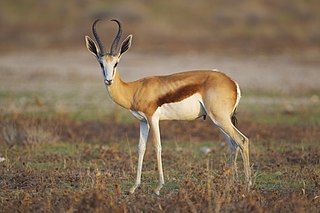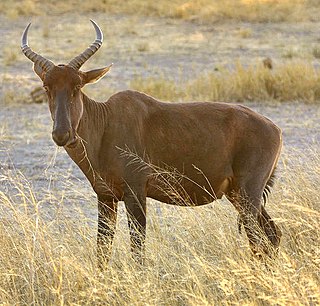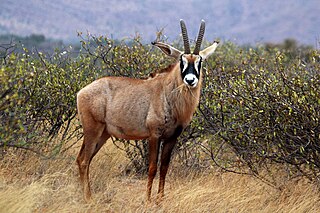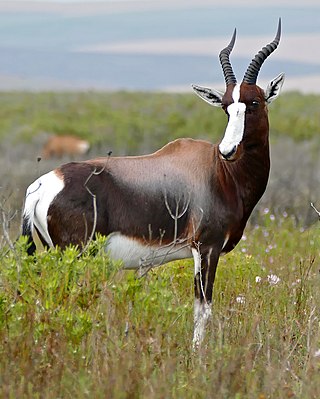
The springbok or springbuck is an antelope found mainly in south and southwest Africa. The sole member of the genus Antidorcas, this bovid was first described by the German zoologist Eberhard August Wilhelm von Zimmermann in 1780. Three subspecies are identified. A slender, long-legged antelope, the springbok reaches 71 to 86 cm at the shoulder and weighs between 27 and 42 kg. Both sexes have a pair of black, 35-to-50 cm (14-to-20 in) long horns that curve backwards. The springbok is characterised by a white face, a dark stripe running from the eyes to the mouth, a light-brown coat marked by a reddish-brown stripe that runs from the upper fore leg to the buttocks across the flanks like the Thomson's gazelle, and a white rump flap.

The subfamily Alcelaphinae, of the family Bovidae, contains the wildebeest, tsessebe, topi, hartebeest, blesbok and bontebok, and several other related species. Depending on the classification, there are 6–10 species placed in four genera, although Beatragus is sometimes considered a subgenus of Damaliscus, while Sigmoceros is sometimes considered for the Lichtenstein's hartebeest.

The roan antelope is a large savanna-dwelling antelope found in western, central, and southern Africa. Named for its roan colour, it has lighter underbellies, white eyebrows and cheeks and black faces, lighter in females. It has short, erect manes, very light beards and prominent red nostrils. It is one of the largest antelope, measuring 190–240 cm (75–94 in) from head to the base of the tail, and a 37–48 cm (15–19 in) long tail. Males weigh 242–300 kg (534–661 lb) and females 223–280 kg (492–617 lb). Its shoulder height is around 130–140 cm (51–55 in).

The sable antelope is a large antelope which inhabits wooded savanna in East and Southern Africa, from the south of Kenya to South Africa, with a separated population in Angola.

The hirola, also called the Hunter's hartebeest or Hunter's antelope, is a critically endangered antelope species found as of now, only in Kenya along the border of Somalia. It was first described by the big game hunter and zoologist H.C.V. Hunter in 1888. It is the only living member of the genus Beatragus, though other species are known from the fossil record. The global hirola population is estimated at 300–500 animals and there are none in captivity. According to a document produced by the International Union for Conservation of Nature "the loss of the hirola would be the first extinction of a mammalian genus on mainland Africa in modern human history".

The common tsessebe or sassaby is the southern, nominate subspecies of Damaliscus lunatus, although some authorities have recognised it as an independent species. It is most closely related to the Bangweulu tsessebe, sometimes also seen as a separate species, less to the topi, korrigum, coastal topi and tiang subspecies of D. lunatus, and less to the bontebok in the same genus. Common tsessebe are found in Angola, Zambia, Namibia, Botswana, Zimbabwe, Eswatini, and South Africa.

The bontebok is an antelope found in South Africa, Lesotho and Namibia. D. pygargus has two subspecies; the nominate subspecies, occurring naturally in the Fynbos and Renosterveld areas of the Western Cape, and the blesbok occurring in the Highveld.

The hartebeest, also known as kongoni or kaama, is an African antelope. It is the only member of the genus Alcelaphus. Eight subspecies have been described, including two sometimes considered to be independent species. A large antelope, the hartebeest stands just over 1 m at the shoulder, and has a typical head-and-body length of 200 to 250 cm. The weight ranges from 100 to 200 kg. It has a particularly elongated forehead and oddly-shaped horns, a short neck, and pointed ears. Its legs, which often have black markings, are unusually long. The coat is generally short and shiny. Coat colour varies by the subspecies, from the sandy brown of the western hartebeest to the chocolate brown of the Swayne's hartebeest. Both sexes of all subspecies have horns, with those of females being more slender. Horns can reach lengths of 45–70 cm (18–28 in). Apart from its long face, the large chest and the sharply sloping back differentiate the hartebeest from other antelopes. A conspicuous hump over the shoulders is due to the long dorsal processes of the vertebrae in this region.

Abbott's duiker, also known as minde in Swahili, is a large, forest-dwelling duiker found only in a few scattered enclaves in Tanzania. It may be a subspecies of the yellow-backed duiker. It is very rare, and the first photograph of an Abbott's duiker in the wild was taken as recently as 2003.

The suni is a small antelope of the family Bovidae, and one of the smallest ungulates on earth. It occurs in dense underbrush from central Kenya to KwaZulu-Natal in South Africa. It is also found on the island of Zanzibar off of Tanzania.

The giant sable antelope or royal sable antelope, also known in Portuguese as the palanca-negra-gigante, is a large, rare subspecies of the sable antelope native and endemic to the region between the Cuango and Luando Rivers in Angola.

The black-fronted duiker is a small antelope found in central and west-central Africa.

The blue wildebeest, also called the common wildebeest, white-bearded gnu or brindled gnu, is a large antelope and one of the two species of wildebeest. It is placed in the genus Connochaetes and family Bovidae, and has a close taxonomic relationship with the black wildebeest. The blue wildebeest is known to have five subspecies. This broad-shouldered antelope has a muscular, front-heavy appearance, with a distinctive, robust muzzle. Young blue wildebeest are born tawny brown, and begin to take on their adult coloration at the age of 2 months. The adults' hues range from a deep slate or bluish-gray to light gray or even grayish-brown. Both sexes possess a pair of large curved horns.

Bontebok National Park is a species-specific national park in South Africa. It was established in 1931 to ensure the preservation of the Bontebok. It is the smallest of South Africa's 19 National Parks, covering an area of 27.86 km2 The park is part of the Cape Floristic Region, which is a World Heritage Site.

Damaliscus lunatus is a large African antelope of the genus Damaliscus and subfamily Alcelaphinae in the family Bovidae, with a number of recognised geographic subspecies. Some authorities have split the different populations of the species into different species, although this is seen as controversial. Common names include topi, sassaby, tiang and tsessebe.

Salt's dik-dik is a small antelope found in semidesert, bushland, and thickets in the Horn of Africa, but marginally also in northern Kenya and eastern Sudan. It is named after Henry Salt, who was the first European to acknowledge the species in Abyssinia in the early 19th century.

Abe Bailey Nature Reserve is a protected area in the Merafong City Local Municipality in Gauteng, South Africa. It is situated near Carletonville, beside the township of Khutsong on the West Rand. It is about 4,200 hectares in size.

The Mongalla gazelle is a species of gazelle found in the floodplain and savanna of South Sudan. It was first described by British zoologist Walter Rothschild in 1903. The taxonomic status of the Mongalla gazelle is widely disputed. While some authorities consider it a full-fledged monotypic species in the genus Eudorcas, it is often considered a subspecies of Thomson's gazelle, while other authorities regard it as subspecies of the red-fronted gazelle.

The Bangweulu tsessebe is a population and possible taxon of Damaliscus lunatus, which are large African antelopes of the grasslands. This population is presently restricted to northern Zambia in the wild, although it was recorded as occurring in neighbouring southernmost Democratic Republic of the Congo in the 1940s. Also seen as the northernmost population belonging to the nominate southern sassaby subspecies, in 2003 it was described as a new species, only to be downgraded to a subspecies a few years later. Its taxonomic status is unclear as of 2021. As an individual sassaby of this taxon cannot be clearly distinguished from populations to the south, the taxon was defined using an experimental suite of statistical techniques applied to a sample set, based on multivariate analysis, and recognised under an experimental new taxonomy. Nominate sassaby antelopes become progressively darker on average in the northern populations, and on average have slightly thicker horns at the base of the skull, but those of northern Zambia are the darkest and with the most robust horns on average.

The preorbital gland is a paired exocrine gland found in many species of artiodactyls, which is homologous to the lacrimal gland found in humans. These glands are trenchlike slits of dark blue to black, nearly bare skin extending from the medial canthus of each eye. They are lined by a combination of sebaceous and sudoriferous glands, and they produce secretions which contain pheromones and other semiochemical compounds. Ungulates frequently deposit these secretions on twigs and grass as a means of communication with other animals.






















